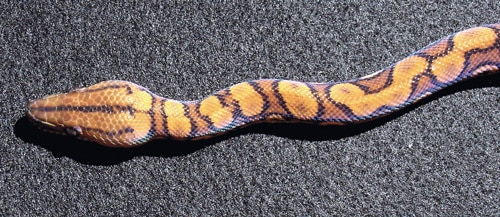Brazilian rainbow boa snake care and information.
Do you remember the sight of your first rainbow boa? Can you picture the colors resembling the palette of an artist painting a fiery sunset? Now, allow the scales to tease the sunlight into revealing a display of deep iridescence.
My love affair with the Brazilian rainbow boa was born in the mid-1980s. My mom had just introduced me to the snake freak who lived in our neighborhood. As he showed me his collection, I became enamored with the colors of the colubrids and the subtle earth tones of the rosy boas. But nothing matched the radiant beauty of what was yet to come. As he slid the plastic shoebox out of its compartment, there, beaming on the paper towel at the bottom of the enclosure, was the most majestic little beast I had ever seen. At the time, Brazilian rainbow boas were well out of my price range. I would have to wait five or six years before owning my first pair.
In 1990 it happened, and the wait was well worth it. I’ve been happily keeping and breeding these animals for the past 18 years. The old snake freak has long ago moved out of the neighborhood and has since been replaced by a newer, younger, much better-looking snake freak. Thanks, Mom.
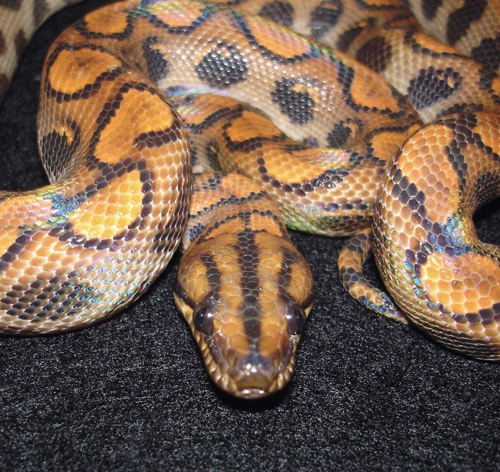
Outlined in black, saddles contain yellow to orange to fiery-red crescent-shaped markings.
Wild Rainbows
Nine recognized subspecies of Epicrates cenchria are found from southern Mexico through Central America and throughout most of South America. The Brazilian rainbow boa (E. cenchria cenchria) is the most commonly kept subspecies in captivity. Its natural range includes the Amazon River Basin from Peru and Brazil to Colombia and northeast to Suriname. They inhabit tropical and subtropical broad-leaved forests described as hot and wet. A steady temperature between 73 and 90 degrees Fahrenheit is expected year round, and annual rainfall varies from 58.5 to 136.5 inches depending on the particular location. Humidity is fairly constant at 60 to 70 percent.
Brazilian rainbows are a popular subspecies because of their outstanding appearance. Males reach sizes of 5½ to 6 feet long. Large females can grow to 6 to 7 feet and weigh up to 9 pounds. They are impressive animals but not giant snakes. They never get so big that one person can’t handle them alone.
Their color ranges from orange to deep-red with orange to red saddles running down their backs. Each saddle is bordered by black. Usually three distinct black stripes run along their heads, and black circles containing yellow to orange to fiery-red crescent-shaped markings run along each side of the animal’s body from head to tail. These markings contrast their stark-white ventral surfaces, and they are further enhanced by the iridescence radiating from their scales, which reflect hues of blue, green and purple thanks to chemicals called “purines” located in cells of the epidermis.
This busy pattern and bold coloration serve to break up the outline of their bodies as they camouflage themselves among debris on the forest floor. They don’t possess any pattern on their ventral surface because it is never exposed and therefore doesn’t need to blend in.
Brazilian rainbow boas are nocturnal, and they often become active an hour or two after sundown. They may be found searching for a drink or for a new daytime hiding spot. Once they have found a suitable location, they assume a sit-and-wait position with their heads extended from their shelters. Rather than actively hunting down their prey, they probably seek out high-rodent-traffic areas. Once such an area is found, they patiently wait for their next meal.

The author’s Brazilian rainbow boa enclosures in this photo each measure 36 inches long by 24 inches wide by 21 inches tall.
Caging Particulars
Brazilian rainbow boas thrive in captivity and make excellent pets as long as their requirements are met. The first thing to consider is the cage. I have kept them in many types of enclosures over the years. Plastic shoeboxes of various sizes, glass aquariums and custom-built wooden habitats all suffice. Whatever you use, it should be of appropriate size and escapeproof. Appropriate floor dimensions for baby Brazilian rainbow boas range from plastic shoeboxes measuring roughly 12 inches long by 6 inches wide by 4 inches tall to 10-gallon glass aquariums measuring 20 inches long by 10 inches wide by 13 inches tall. It has been my experience that anything larger than this is just too big for a small snake. The temperature range throughout a too-large cage becomes too wide for the animal to thermoregulate.
Once the snakes are approximately 2 feet long, I move them to larger plastic sweaterboxes. I use sweaterboxes 23 inches long by 16 inches wide by 6 inches tall. Brazilian rainbow boas that are 2 feet long can also be comfortably kept in 20- to 30-gallon aquariums.
Once the animals are 4 to 6 feet long, I move them into their adult enclosures. These are custom-built wooden cages. They are lined on the inside with Formica brand laminate to stand up to wear and tear from the snakes, moisture and cleaning. Adult cages are a minimum of 36 inches long by 24 inches wide by 21 inches tall. This size is appropriate for housing one animal or a breeding pair.
I also have a few larger enclosures that measure 48 inches long by 24 inches wide by 21 inches tall. These cages are used for breeding groups (two or more animals). A 100-gallon aquarium will also work for adult rainbow boas.
Regardless of the size of the cage or the age of the snake, I always arrange the inside the same way. A water dish is placed in the cool end of the cage away from the heat source. In the warm end of the cage, at least one hiding spot is provided. If the cage is large or shared by multiple animals, two or three hiding spots are included. Many things work as hide spots: wooden or Rubbermaid boxes with holes in the side, pieces of broken pottery, cork bark, slate propped on bricks, and even cinder blocks laid on their sides. The snakes seem to love to wedge into the holes of the cinder blocks.
Whatever items you use, make sure the hide spots are pleasing to the eye, easy to remove for cleaning and arranged in such a way that they cannot topple over and hurt the animals. Rainbow boas tend to remain hidden during the day and seem to feel more comfortable if they can get out of sight.
Handle Frequently
Baby rainbow boas are defensive. This is understandable because anything that might pick them up in the wild is probably going to eat them. They need to be handled regularly to tame them. Once your snake has acclimated to its new home and appears to be eating regularly, feel free to handle it frequently. Depending on the size of the meal they have recently eaten, give them 24 to 72 hours to digest before handling. Really, the longer you wait, the better. Imagine being picked up and moved around soon after you have eaten a large meal. This can lead to regurgitation. With consistent, gentle handling, baby Brazilians tame down in a matter of weeks.
Substrate Swap
Like my rainbow boas’ cages, their substrate changes with the size of the snake. Babies are kept on newspaper or paper towel. These are both easy to replace when cleaning. Adults are kept on decorative western bark mulch from Earthgro. Its reddish-brown color gives it a natural look. Many things work to line your snake’s cage. Consider appearance and ease of cleaning when making your choice. As with most reptiles, it is important to avoid using cedar or redwood shavings because these contain chemicals toxic to snakes.
As soon as the babies deposit feces or urates on their paper towels, the lining is replaced. Adults are another story. Their cages can be spot-cleaned as necessary. Any sheds, feces or urates are removed as they are generated. The substrate lining adult enclosures is completely replaced every three or four months.
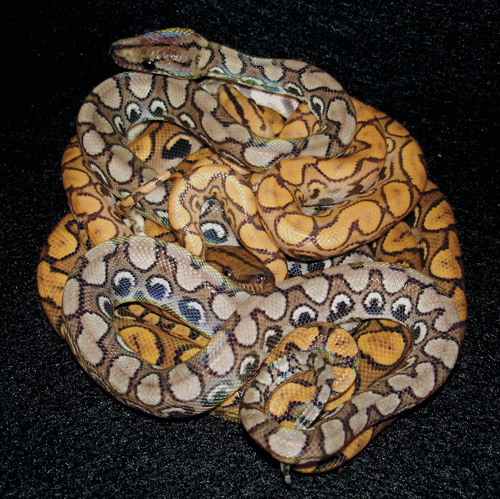
Three rainbow boa types are in this picture. The light-orange snake is hypomelanistic, the gray one is anerythristic, and the red-orange one is the normal type.
Tropics in Captivity
I have always used Flexwatt laminated heating elements, which must be used in conjunction with a dimmer switch or thermostat, to heat my enclosures. By connecting my Flexwatt heater to a thermostat with a remote sensor, such as the Helix DBS-1000 or Herpstat from Spyder Robotics, precise temperatures can be achieved in the warm end of the enclosure. Mount the heater to the bottom of the cage using sheets of aluminum, which can be purchased at any hardware store. Screwing the aluminum sheet to the bottom of the cage with the Flexwatt in between keeps the heater’s entire surface flush with the cage. This method of heating is successful even with cages made of three-fourths-inch-thick plywood. The Flexwatt can be mounted to the outside of the enclosure.
The cage can then be mounted up off of the floor using rubber feet, wooden blocks or bricks. Keeping the cage elevated like this allows heat to dissipate. Never sandwich your heat source between two wooden surfaces! This allows too much heat to build up and can lead to a fire.
Rainbow boas depend upon environmental conditions to regulate their internal temperatures. When setting up their enclosures, it is best for snakekeepers to provide them with a range of temperatures. A cool end of 72 degrees and a warm end of 85 degrees provide an adequate gradient for your snake. This temperature range is sufficient for both hatchlings and adults. It is important to note that the temperatures should be measured with an accurate thermometer on the floor of the cage where the snake spends the most time.
Humidity in the Brazilian rainbow boa’s native habitat is high. Although this should be a consideration when keeping these animals in captivity, an exact percentage isn’t critical. Lightly misting babies once a day and letting the water evaporate overnight keeps their sheds in one piece. Their cages are ventilated, so any moisture evaporates over the course of a 24-hour period. Adult cages are sprayed but not on a regular basis. Every few days they get a spritz. However, shedding adults are sprayed down once per day. They seem to be able to take care of much of their own needs for water if provided with a large tub in which to soak. My tubs measure 13 inches wide by 13 inches long by 7 inches tall, and I fill them halfway with water. This is sufficient for one full-grown Brazilian. It also serves as a water dish.
If you live in a very dry climate, you may have to mist more often to keep the humidity up. I recommend misting rather than leaving dampened moss in the cage because the moss may promote bacterial and fungal growth. I have lost one animal due to a humidity problem. It was a small rainbow boa in a large glass aquarium with a screen top. The enclosure held absolutely no moisture, and this caused the animal to suffer a few bad sheds. Stuck eye caps led to eye infections. Eventually, the animal died from what I believe was just bad husbandry on my part. I now try to “listen” more carefully to my animals.
These snakes should always have access to fresh water. Change it weekly, and use water dishes large enough for the animal to get into. Rainbow boas can often be observed soaking in their water dishes. There is much discussion among herpetoculturists about filtered and purified water. Untreated water from the tap can be used because hard water containing calcium and magnesium salts is safe for reptiles.
Dry Eyes
Denting or pitting of the eye cap can occur in Brazilian rainbow boas. I have always associated this with dry conditions. I have seen discussions on Internet forums where other snakekeepers have corroborated this. The condition usually clears up if better access to water is provided or humidity is increased. The condition can be slow to correct itself. Sometimes it persists for a year or more. I have not noticed it to be detrimental to the animal.
Food Small and Plentiful, or Large and Scarce
Over the years I have gone back and forth over small, frequent meals versus larger, infrequent ones. It seems to me that opportunistic predators such as Brazilian rainbow boas would lean more toward the latter. I guess this really depends on the particular snake and its environment. Currently, I feed smaller meals more frequently. The general rule of thumb is a rat or mouse of the same girth as the snake’s widest point. These meals should be offered once per week.
Food items may be offered live, freshly killed, or frozen and thawed. Live food should be used with caution because rodent bites can occur. If live food is offered, it should never be left in a cage overnight. Serious injuries can occur as a result of this practice. Frozen prey should be thoroughly thawed using hot tap water before it is offered to your animal. Thawing and warming has two benefits. It avoids the risk of “shocking” your animal’s system due to ingesting frozen food, and it also enforces the illusion of a live, warm-blooded prey item.
Thawed or freshly killed food items should be offered to your snake on tongs. Wiggle the food in front of the snake’s face or gently tap the snake on the nose with it to illicit a strike. When the snake strikes and holds, release the food item. The snake will know what to do with it.
If snakekeepers choose to go with larger, infrequent meals for their snakes, the size of the feeder they select depends upon the size of the snake. If there is ever any question, it’s always safe to stick with this rule: Feed a snake a meal as wide as the snake’s widest point. They will eat a food item this size once per week unless they are fasting males or gravid females.
Animals should not be fed together in the same enclosure. If you have to keep two animals together, move one of them to a temporary container during feeding time. If two snakes end up going for the same food item, one can end up swallowing the other by mistake. I have actually pulled the head of one animal from the mouth of another. This is a mistake I will never make again.
During the breeding season, when I commonly have multiple animals per enclosure, they are separated into plastic sweaterboxes for 24 hours before being offered a meal. This gives them a chance to relax and acclimate before being fed. Aggressive feeders may not need this time. You may be able to get away with separating the animals and feeding them right away.
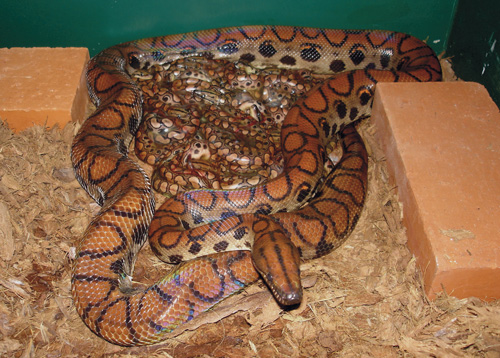
To sex babies, run a thumb and ring finger down the snake’s ventral and dorsal area past the cloaca. In males you will feel two bumps as you come to the end of the hemipenes.
Breed with Patience
Brazilian rainbow boas are not difficult to breed in captivity. However, the task requires some patience. Pre-breeding conditioning begins with a nighttime drop in temperature.
I have based my cooling cycle on the information given in The Reproductive Husbandry of Pythons and Boas by Richard A. Ross and Gerald Marzec. This cycling regimen has produced consistent results for me for the past 18 years. The cycle begins on November 1 with a nighttime temperature drop to 84 degrees. Every seven days the temperature drops 2 degrees until 68 degrees is reached as a nighttime low. This usually occurs mid-December. During the cooling period, the daytime temperature remains at 85 degrees, and males and females remain separate and are fed normally. A temperature of 68 degrees is held as a nighttime low for three weeks. Then, the nighttime low is gradually increased two degrees per week until it is back to 85 degrees around the end of January or the beginning of February.
As the animals warm, I watch for signs that males and females are ready to meet. Males often go off feed or leave shed epidermal layers of their hemipenes in the water dish to signal that they are ready. Females begin to show signs of swelling as their ovaries fill with developing follicles. They often move off their heat sources, and they spend their days in the cooler sides of the cage or bask in their water dishes. These behaviors may show up as early as February or as late as April or May.
It’s OK to introduce animals before these signs are exhibited. I often recommend that beginners do so. Don’t be surprised if animals ignore each other for the first weeks or even months. They will come around when they are ready.
Once the snakes are interested, females lead males on a chase around the enclosure, which can last several hours. During this time the male tongue- and spur-flicks the female. He moves along the female’s body and aligns his tail with hers only to have her take off again. The chase usually ends in copulation, tails entwined. As in many other species, copulation can last several hours. Repeat copulations take place every few days during the next several weeks.
Just as there is no hurry to introduce these snakes, there is no hurry to separate them. The snakekeeper’s experience dictates how long a breeding pair must be kept together before they breed. Only when the keeper sees signs that the female may be pregnant is there a need to separate the pair. Some signs are a female’s preference for warm temperatures and a refusal of food. During the pre-breeding and breeding period, females can be found throughout their enclosures; they don’t stay in one place. Once gravid, they seek a nice, warm basking spot and remain there for up to four and a half months. Many females go off feed abruptly when gravid; others eat all the way through gestation.
For a long time, the gestation period for these livebearers has been elusive. Breeders have been able to give estimates of when babies will be born based on the last copulation and first food refusal, but nothing exact. Recently, I read a post on a popular Internet forum regarding gestation period for boa constrictors. In the post, snake breeder Jeff Ronne mentioned that parturition (birth) takes place 105 days after a post-ovulatory shed.
A quick check of my records confirmed a similar timetable for Brazilian rainbow boas. Of two females that produced in 2006, one shed 107 days and the other 109 days before parturition. During the 2007 breeding season, three animals produced clutches for me. All three went through a post-ovulatory shed. These animals gave birth 104, 105 and 110 days after their post-ovulatory sheds.
When this data was compared to that of another rainbow boa breeder, similarities were observed. Snake breeder Dave Colling notes gestation periods for his females ranges between 129 and 135 days. We believe the variation in time is due to the different body temperatures of gravid females. My females maintained an average body temperature of 86 degrees and experienced a shorter gestation. Colling’s animals were kept at 80 degrees. The lower body temperature led to a longer gestation.
Several additional behaviors can be used to gauge the arrival of newborns. Roughly two to four weeks before giving birth, females get a little restless. They may be found lying on their sides or their backs. This may be to achieve particular temperatures in the final days of gestation, or it may be to better position offspring for birth. The female also seems to “wake up” at this time. She may spend a little time in the cool end of the cage, or she may cruise around looking for a place to give birth. Once these signs are observed, I remove cage furniture so things are not as crowded and place plastic plants in the water dish to prevent babies from drowning.
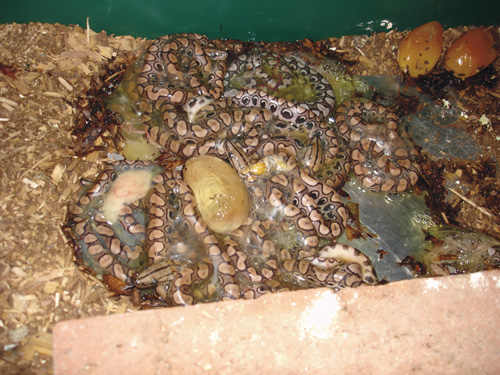
Babies are born in a translucent, membranous sac, and they tear their way out of it.
Brazilian Babes
When the big day does arrive, it is a sight to behold. Babies are born inside their own amniotic sac, which they must tear out of in order to take their first breath. The whole mess looks like a gelatinous, squirming pile of goo. Yet there’s no prouder moment in a breeder’s life than staring at that funk at 3 a.m. before you have to get up for work in a matter of hours.
Babies can be sexed and fed their first day of life. I begin by palpating for hemipenes. This involves running my thumb and ring finger, respectively, down the ventral and dorsal surfaces past the cloaca. If the animal is a male, you’ll feel a couple of bumps as you come to the end of the hemipenes. This occurs anywhere from the fifth to eighth ventral scale past the cloaca. In females, you will not feel these bumps. I like this method of sexing because it is completely noninvasive. If you apply steady but gentle pressure, there is very little chance of doing damage to the spinal column or reproductive organs.
After neonates are sexed, weighed and set up in separate shoeboxes, they are offered food that evening. Thawed pinky rats are offered as the first meal. Most of them eat the first time, and then it’s off to the races.
These are exciting times to keep and breed Brazilian rainbow boas. Their colors truly stand out whether you are attracted to genetic morphs or enamored by the radiance of the normal snakes. And although these snakes reach large, impressive sizes, they don’t get so big that they require rabbits or large enclosures, and they tame down nicely. Like an artist’s palette, the Brazilian rainbow boa has a color for everyone.
Availability
Brazilian rainbow boas are generally born midsummer to fall. Babies become available late summer through winter. As with any reptile, getting them from a reputable breeder is best. They are usually available at stores that specialize in reptiles. Available babies are most likely captive bred, but always ask to make sure. Buying over the Internet is popular and a great way to acquire a reptile if you have confidence in the person selling. Ask to see pictures of the actual animal before committing to buy.

